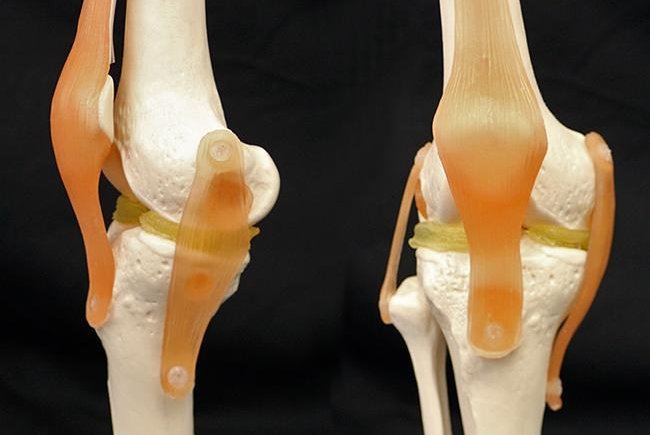A cartilage-mimicking material created by researchers at Duke University may allow surgeons to 3-D print meniscus implants or other replacement parts that are custom-shaped to each patient's anatomy. Photo by Feichen Yang
April 19 (UPI) -- Researchers have developed a cartilage-mimicking material made from 3D-printed hydrogel that may one day allow 3D-printed knee implants in humans.
The hydrogel-based material developed by researchers at Duke University is the first to match human cartilage in strength and elasticity while also remaining 3D-printable and stable inside the body.
The material is used to replace the menisci, the built-in shock absorbers in knees that sit between the thigh and shin bones to cushion every step. The meniscus loses its ability to heal on its own as we age and is often vulnerable to tears and damage from sports injuries.
Up until now, available implants to replace the meniscus did not match the strength and elasticity of the original cartilage or were not biocompatible.
Researchers were able to use a $300 3D printer to create custom menisci for a plastic model of a knee using hydrogel, which are biocompatible and have similar molecular structure to cartilage.
"We've made it very easy now for anyone to print something that is pretty close in its mechanical properties to cartilage, in a relatively simple and inexpensive process," Benjamin Wiley, associate professor of chemistry at Duke, said in a press release.
Researchers mixed together two different types of hydrogels -- one stiffer and stronger, and the other softer and stretchier -- to create a double-network hydrogel.
"The current gels that are available are really not as strong as human tissues and, generally, when they come out of a printer nozzle they don't stay put -- they will run all over the place, because they are mostly water," Wiley said.
The double-network hydrogel is created in a way that makes it much stronger than traditional hydrogel.
"The two networks are woven into each other," said Feichen Yang, a graduate student at Duke. "And that makes the whole material extremely strong."
3D printing is already used in orthopedic surgery for hip replacements, cranial plates and spinal vertebrae and are based on virtual 3-D models of a patient's anatomy using MRI and CT scans.
"This is really a young field, just starting out," Wiley said. "I hope that demonstrating the ease with which this can be done will help get a lot of other people interested in making more realistic printable hydrogels with mechanical properties that are even closer to human tissue."
The study was published in ACS Biomaterials Science & Engineering.















